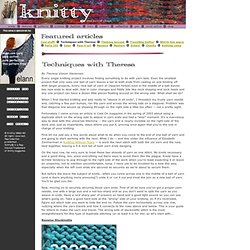

Getting drape from cotton yarn (plus a free pattern!) When I think drape I think silk, sea cell, or bamboo.

I don't think cotton, especially the smooth, sorta stiff mercerized cotton yarn that's ubiquitous in spring and summer knits. But I'm thinking again because Kristin Ohmdahl and Eunny Jang, hosts of Knitting Daily TV, are here to show us all how to knit with cotton and get the drape we want. With the right shaping and pattern, you can get a great result. I have quite a bit of cotton yarn, which I usually use for baby projects; there's just no sense in knitting something non-washable for little ones, and cotton is long-wearing and long-washable. New braided joining method. How to Get Over Your Fear of Knitting Lace. November 30th, 2011 by Guest This is a guest post from Amy Kaspar, Chicago Knitting Examiner for Examiner.com.

Getting over your fear of knitting lace. Are you a newer knitter, ready to break up with the standard knit-and-purl for a yarn over or two? Do you have a lace pattern you want to try, but you are afraid to do so? I have been there…we ALL have been there. Knitting Terms and Abbreviations. This is a comprehensive glossary of common knitting abbreviations that you are likely to find in a pattern.

Wherever it's relevant, I've included links to videos which cover the technique. inch(es) work instructions between parentheses, in the place directed work instructions between brackets, as many times as directed repeat instructions following the single asterisk as directed repeat instructions between asterisks, as directed alt alternate approx approximately beg begin(ning) bet between bind off view continental video view english video color A color B contrasting color cdd centered double decrease. sl2 tog, K1, pass the slipped stitches over (together) view english video view continental video ch chain (using crochet hook).
View video cm centimeter(s) cn cable needle: short knitting needle, used as an aid in the twisting of a cable. cast on view video cont continue cross 2 L cross 2 stitches to the left (to work a cable). Cross 2 R dc double crochet dec(s) decrease(s) Double Knitting weight yarn. Dpn aka dp end of row fl. Tutorial - starting a shawl with a garter tab. When I first started knitting shawls this was one of the things that flummoxed me.

Why would you faff about with knitting a tiny garter stitch rectangle and picking up stitches (my pet hate) when you can just cast on the right amount to start with? Well I asked on Ravelry and was told that it creates a neater and more flexible long edge on shawls knit from the centre neck outwards. Meh, thought I - bet it doesn't. Two versions of "198 yards of Heaven" later and I was converted. Recently someone asked the same question in one of my Ravelry groups and I was able to give the same answer I was given all that time ago. 1. 2. 3. 4. 5. 6.
I have now finished the shawl and the yarn/pattern combination hasn't worked so I've overdyed it with green and blue to create a deep turquoise with some inky pools.Finished object photos to follow but here's a picture of the shawl blocking: Welcome to the Craft Yarn Council and Warm Up America! Knitty.com. Every single knitting project involves finding something to do with yarn tails.

Even the smallest project that only uses one ball of yarn leaves a tail at both ends from casting on and binding off. With larger projects, every new ball of yarn or [heaven forbid] knot in the middle of a ball leaves two new ends to deal with. Add in color changes and fiddly bits like neck shaping and sock heels and any one project can have a dozen little pieces floating around on the wrong side.
What shall we do? Ssk. Knit Tips Tuesday: reading charts - Chicago knitting. (Knit Tips Tuesday is a series designed to offer tips and tricks to both new and seasoned knitters.

Please feel free to contact Amy with any knit tips of your own, to be featured in future articles.) Knitting and purling are a knitter's two basic building blocks for any project; a common phrase in the knitting world is "If you can knit and purl, you can knit anything. " This may be true regarding the stitching aspect of the craft, but knowing in what order the stitches need to be made and understanding how to manipulate them is also necessary. Knitting patterns generally come in two forms: charts, and written instructions. Some patterns will have the entire stitching pattern in both formats, while others will give a portion of the pattern in written instruction and another portion in a chart (this is common on patterns with a detailed or decorative edging).
Familiarize yourself with your pattern: Read your pattern front to back, top to bottom, and left to right before you cast on.